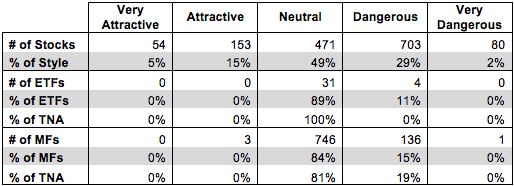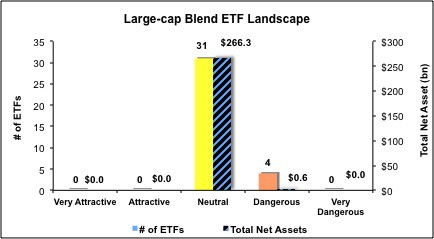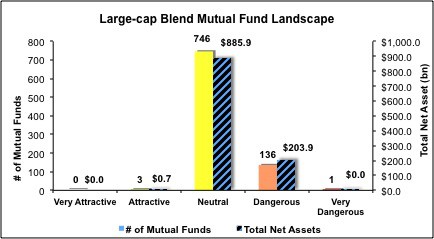The Large Cap Blend style ranks second out of the twelve fund styles as detailed in my Style Rankings for ETFs and Mutual Funds report. It gets my Neutral rating, which is based on aggregation of ratings of 35 ETFs and 886 mutual funds in the Large Cap Blend style as of January 27, 2014. Prior reports on the best & worst ETFs and mutual funds in every sector and style are here.
Figures 1 and 2 show the five best and worst-rated ETFs and mutual funds in the style. Not all Large Cap Blend style ETFs and mutual funds are created the same. The number of holdings varies widely (from 14 to 1013), which creates drastically different investment implications and ratings. The best ETFs and mutual funds allocate more value to Attractive-or-better-rated stocks than the worst, which allocate too much value to Neutral-or-worse-rated stocks.
To identify the best and avoid the worst ETFs and mutual funds within the Large Cap Blend style, investors need a predictive rating based on (1) stocks ratings of the holdings and (2) the all-in expenses of each ETF and mutual fund. Investors need not rely on backward-looking ratings. My fund rating methodology is detailed here.
Investors should not buy any Large Cap Blend ETFs or mutual funds because none get an Attractive-or-better rating. If you must have exposure to this style, you should buy a basket of Attractive-or-better rated stocks and avoid paying undeserved fund fees. Active management has a long history of not paying off.
Get my ratings on all ETFs and mutual funds in this style by searching for Large Cap Blend on my free mutual fund and ETF screener.
Figure 1: ETFs with the Best & Worst Ratings – Top 5
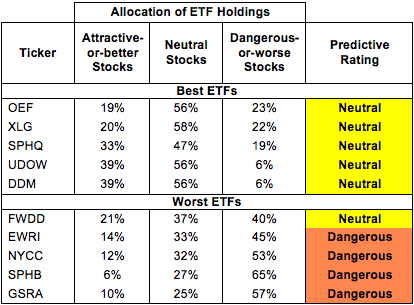 * Best ETFs exclude ETFs with TNAs less than $100 million for inadequate liquidity.
* Best ETFs exclude ETFs with TNAs less than $100 million for inadequate liquidity.
Sources: New Constructs, LLC and company filings
Figure 2: Mutual Funds with the Best & Worst Ratings – Top 5
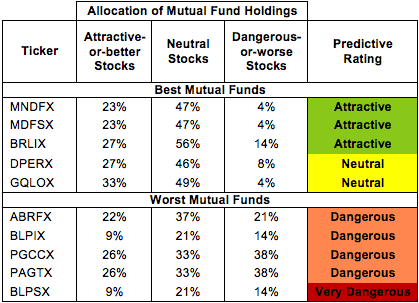 * Best mutual funds exclude funds with TNAs less than $100 million for inadequate liquidity.
* Best mutual funds exclude funds with TNAs less than $100 million for inadequate liquidity.
Sources: New Constructs, LLC and company filings
Nuveen Investment Trust: Nuveen Concentrated Core Fund (NCAFX), Institutional Advisors Large Cap Fund (IALFX), and Hillman Capital Management Investment Trust: Hillman Focused Advantage Fund (HCMAX) are excluded from Figure 2 because their total net assets (TNA) are below $100 million and do not meet our liquidity standards.
iShares S&P 100 ETF (OEF) is my top-rated Large Cap Blend ETF and Manning & Napier Fund, Inc: Dividend Focus Series (MNDFX) is my top-rated Large Cap Blend mutual fund. OEF earns my Neutral rating and MNDFX earns my Attractive rating.
ALPS ALPS/GS Risk-Adjusted Return U.S. Large Cap Index ETF (GSRA) is my worst-rated Large Cap Blend ETF and ProFunds: Bull ProFund (BLPSX) is my worst-rated Large Cap Blend mutual fund. GSRA earns my Dangerous rating and BLPSX earns my Very Dangerous rating.
Figure 3 shows that 207 out of the 1461 stocks (over 20% of the market value) in Large Cap Blend ETFs and mutual funds get an Attractive-or-better rating. However, only 0 out of 35 Large Cap Blend ETFs and 3 out of 886 Large Cap Blend mutual funds (less than 1% of total net assets) get an Attractive-or-better rating.
The takeaways are: mutual fund managers allocate too much capital to low-quality stocks and Large Cap Blend ETFs hold poor quality stocks.
Figure 3: Large Cap Blend Style Landscape For ETFs, Mutual Funds & Stocks
As detailed in “Low-Cost Funds Dupe Investors”, the fund industry offers many cheap funds but very few funds with high-quality stocks, or with what I call good portfolio management.
Investors need to tread carefully when considering Large Cap Blend ETFs and mutual funds, as only a few mutual funds earn my Attractive-or-better rating. No ETFs and 3 mutual funds in the Large Cap Blend style allocate enough value to Attractive-or-better-rated stocks to earn an Attractive rating.
International Business Machines Corp (IBM) is one of my favorite stocks held by Large Cap Blend ETFs and mutual funds and earns my Very Attractive rating. IBM has grown after tax profits (NOPAT) by 13% compounded annually for the last seven years. During this same time frame, IBM has generated positive and increasing economic earnings. IBM earns a top quintile return on invested capital (ROIC) of 16%. One would expect a company with solid NOPAT growth and a high ROIC to be richly valued, but this stock is cheap. At $180/share, IBM has a price to economic book value (PEBV) ratio of 0.9. This ratio implies that IBM’s NOPAT will permanently decline by 10%. The rather large disconnect between the company’s past profit and the market’s expectations seems overly pessimistic. I think IBM is very undervalued.
Red Robin Gourmet Burgers, Inc. (RRGB) is one of my least favorite stocks held by Large Cap Blend ETFs and mutual funds and earns my Dangerous rating. Over the past six years, RRGB has only grown after tax profits (NOPAT) by 2% compounded annually. During the same timeframe, RRGB’s return on invested capital (ROIC) has decreased from ~9% to ~6%. Also, the company has generated negative economic earnings for the past 5 years. Despite the minimal growth and declining ROIC, RRGB’s stock price has almost doubled over the past year. RRGB’s current valuation of ~$65/share implies 15% NOPAT growth compounded annually for 17 years. Given the modest growth RRGB has exhibited in the past, it’s hard to see how it can justify the high profit growth expectations embedded in its stock price.
Figures 4 and 5 show the rating landscape of all Large Cap Blend ETFs and mutual funds.
My Style Rankings for ETFs and Mutual Funds report ranks all styles and highlights those that offer the best investments.
Figure 4: Separating the Best ETFs From the Worst Funds
Figure 5: Separating the Best Mutual Funds From the Worst Funds
Review my full list of ratings and rankings along with reports on all 35 ETFs and 886 mutual funds in the Large Cap Blend style.
Kyle Guske II contributed to this report.
Disclosure: David Trainer and Kyle Guske II receive no compensation to write about any specific stock, sector, style or theme.

